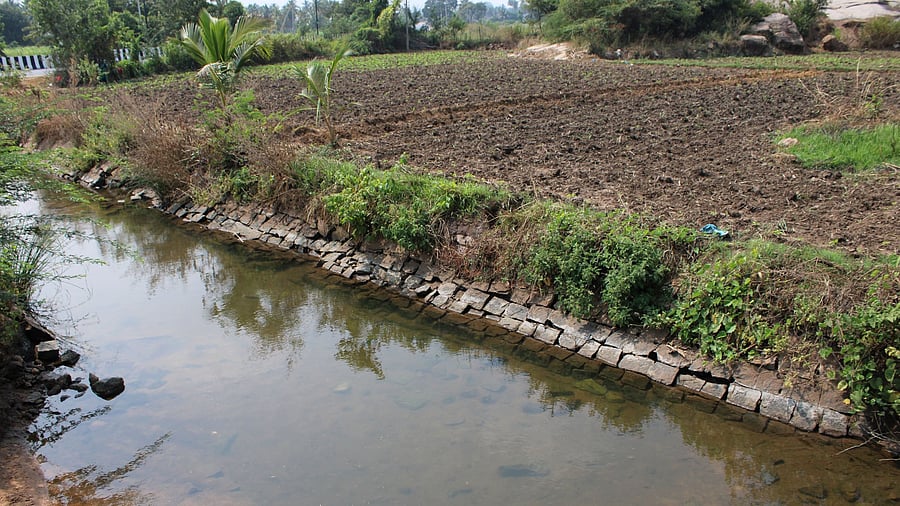
Photo credit: B S Adappa
Various water bodies, step wells, anicuts and canals can be found in Hampi. There are dozens of structures such as the step well near the Mahanavami Dibba, the Manmatha Honda next to Virupaksha temple, Balakrishna Honda next to Krishna temple and several kalyanis along the road leading to Vijaya Vithala temple. There are water-based monuments like Queen’s Bath, Octagonal Bath and the Kuparama Vatike near Malapanagudi.
Besides these, from Hospet to Bichchali in Raichur, 18 small anicuts were constructed. Water was supplied through the canals from the Tungabhadra river. Most of these were built during the reign of the Vijayanagara kings, to irrigate nearly 11,000 hectares of land by placing anicuts without inundating even an acre. The canal irrigation system is still in use today.
Among the 18 canals, the Raya canal is the most important. It is the longest structure and irrigates the largest area. This canal started from the Kuruvagadde anicut, built on the Tungabhadra river near Hoskote village during the reign of the Vijayanagara kings. Currently, this area is submerged in the Tungabhadra reservoir. Water is now supplied to this canal from the reservoir.
Eighteen villages of Hospet taluk are benefiting from this canal. The Raya canal alone covers 2,300 hectares. The current length of the canal is 28 km. Before the construction of the Tungabhadra reservoir, its length was about 40 km.
The canal passes beside Hospet city, runs through Nagenahalli, Gudi Obalapura, and Singanathanahalli, before joining Kamalapura lake. After Nagenahalli, the Raya canal takes dozens of twists and turns, running halfway through the hills for several kilometers.
Portuguese-Jewish traveler Fernao Nuñez, who visited Vijayanagara during 1534-1537, writes in his memoir: “A canal was dug from the Tungabhadra river 15 miles away to bring water to the capital. For the canal, many rocks were broken at the foot of the hill to make way, it was an adventure work.”
Monuments on the banks
Near the Tungabhadra reservoir, a short distance from the Raya canal, is a huge ‘hebbagilu’ dating back to the Vijayanagara period. Records call it ‘gate of Goa’. There are several ruined stone mantapas near Nagenahalli. There is also an ancient Shiva temple near Kalaghatta road. This too, is in ruins.
A little above the canal near Singanathanahalli hill, monuments like a Saraswati mandir can be seen. Here are traces of what used to be a sprawling temple and residential area. There is no doubt that the Raya canal was the source of water here. There is a big banyan tree near the Kamalapura lake where the canal ends and a ruined mantapa can be seen.
While there are no inscriptions which specifically mention when the Raya canal was constructed, since it passed through various parts of the Vijayanagara kingdom along its course, it has found mention. In 1521 AD, it is mentioned in an inscription that Srikrishnadevaraya built an anicut for Raya canal near Ramanagadde. This inscription is submerged in the backwater of the reservoir at present. Historians believe that Krishnadevaraya may have built an additional anicut to increase the water flow of the canal.
Additionally, Kamalapur lake was built in 1420 AD, during the reign of Deva Raya II. It was then called Chikka Raya lake. So, it can be inferred that the Raya canal was built around the time Devaraya II reigned and was improved by his successors.
The banks of the canal, which was built centuries ago with mud, collapsed in some parts, and disturbed the smooth flow of water. Keeping this in mind, Karnataka Neeravari Nigama Limited (KNNL) is modernising the canal with concrete walls. “Care has been taken to prevent any damage to the monuments on the bank of the canal and not to break stones and rocks”, says K B H Shivashankar, executive engineer, KNNL, Tungabhadra reservoir division.
“Twenty to thirty years ago, Raya canal modernisation work was done in some parts, where canal banks were disturbed. But at present, modernisation is going on all along the canal length, which is good for farmers,” says Sreenivas Devaramani, a resident of Nagenahalli village.
R Doraiswamy, team leader of the consultants working on the modernisation project says, “These canals were repaired several times before and after independence to get sufficient water for irrigation. All precautions are being taken to preserve heritage monuments and old structures in and around the canals with the guidance of the Archeological Survey of India.”
The Raya canal is testament to the sophistication of construction technology in the past. It stands as a gift given by the kings of Vijayanagara.